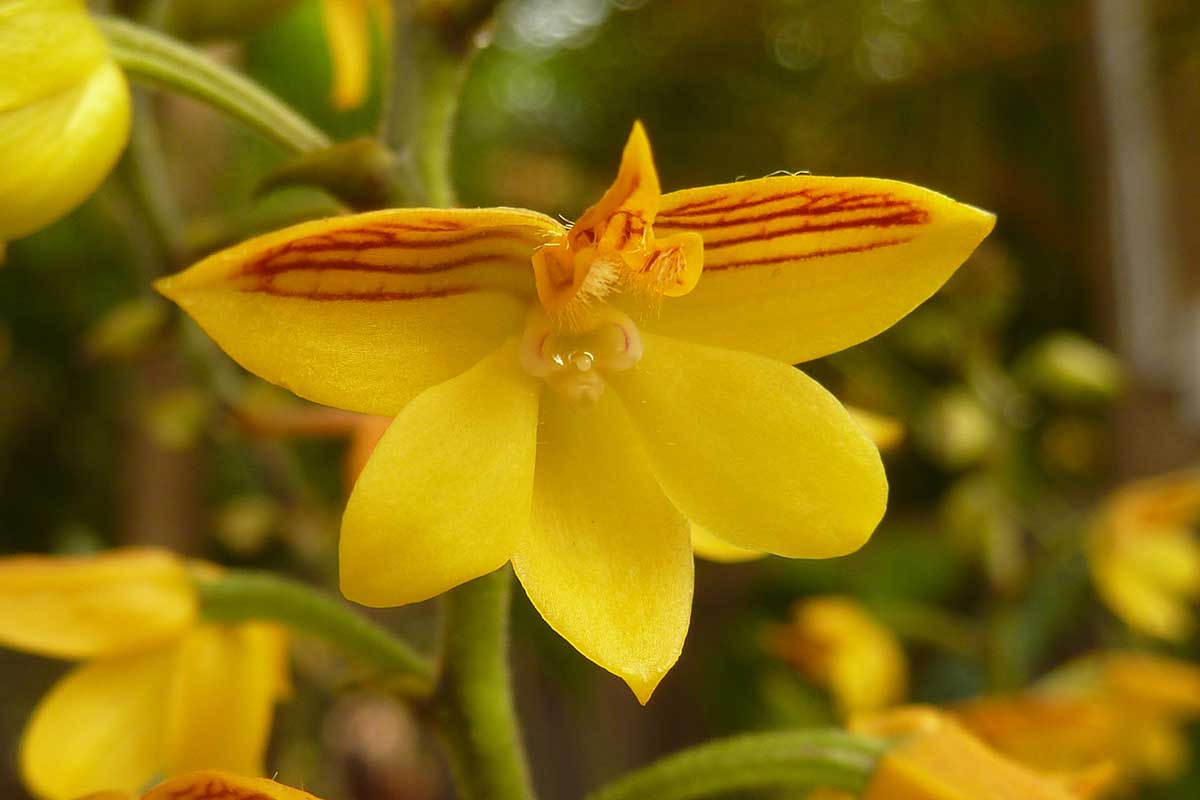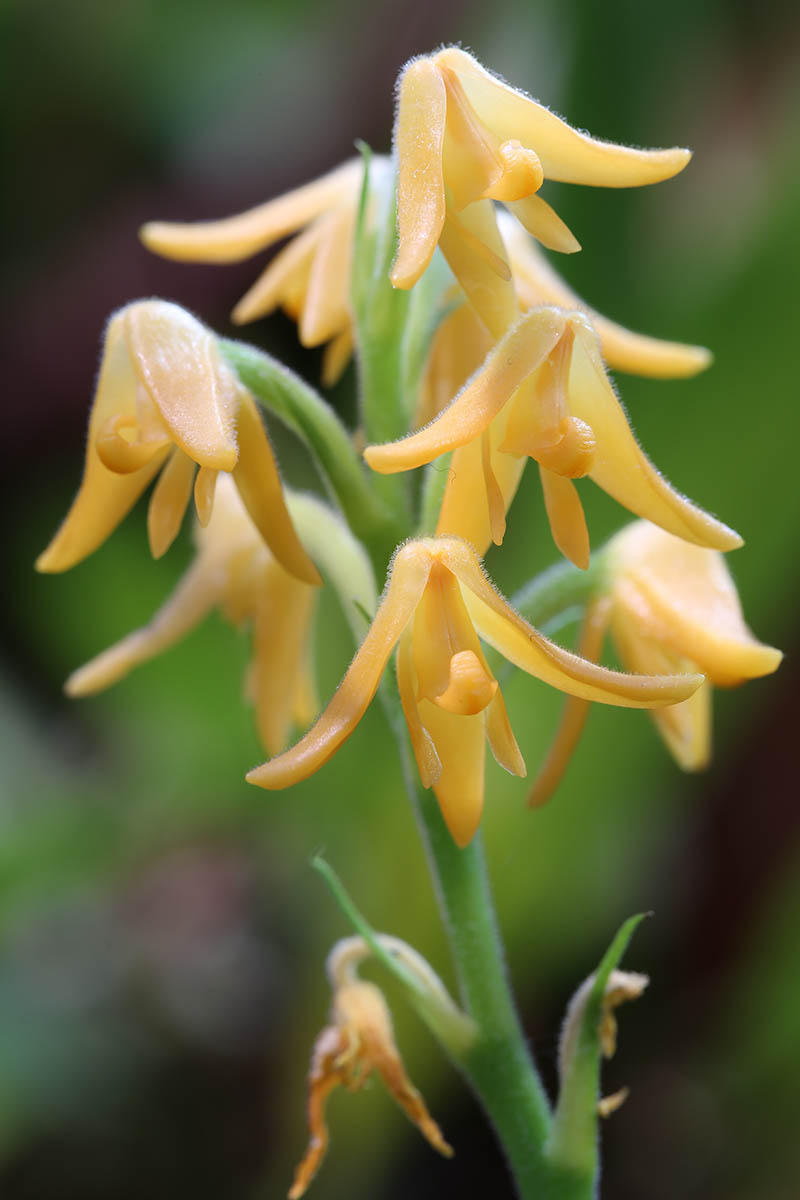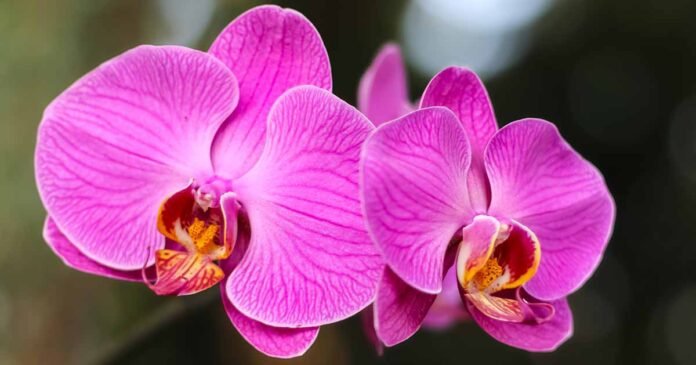Phragmipediums are warm to intermediate growers and require bright, indirect light.
Intermediate and advanced orchid enthusiasts will be the most successful growing phragmipediums, as they have very specific moisture requirements.
Most species require a damp potting medium, and some are even grown with their pots sitting in saucers of water – a condition which would put many houseplants on the express train straight to Root Rot Central.
In addition to these particular hydration needs, these orchids also require filtered, distilled, or rainwater that has not been chemically treated, and humidity between 60 and 70 percent.
If the fascinating flowers of these moisture-loving orchids fill you with deep admiration, Phrag. caudatum is an excellent species to start with.
Phrag. caudatum tolerates warmer temperatures and is not as thirsty as its relatives, making it one of the more accessible phragmipediums to grow.
The long petals and sepals are pale greenish-yellow with a darker greenish-yellow pattern that might remind you of crackled porcelain, surrounding a ruddy, pouch-shaped lip.
19. Polystachya
Polystachya is a genus composed mostly of epiphytes, with some lithophytes, and more rarely, terrestrials.
With over 240 species, the members of this genus are native to tropical and subtropical habitats in Africa, the Americas, and Asia.

Also called “yellowspike orchids,” these small to medium-sized, compact plants are sympodial and produce pseudobulbs or reedlike stems topped with leathery, fleshy leaves. Some species are deciduous.
These plants produce spikes with many small, fragrant flowers, usually in shades of yellow, orange, white, or green. Their inflorescences last one month or longer, with some species blooming on and off throughout the year.
The flowers of these plants are non-resupinate, meaning the lip of the flower is on the top rather than the bottom, making them look as if they’re upside down compared to other orchids such as phals and oncidiums.
Most polystachyas are warm to intermediate growers and require bright to very bright light.
Those with prominent pseudobulbs have a greater water storage capacity and can go longer without water than those with reedlike stems.
While it’s best to check the moisture needs of your particular hybrid or species, as a general rule, it’s best to wait until the substrate has almost dried out before watering it.
Those that are deciduous should be watered amply during their period of active growth, but should receive a rest period (while leaves are gone) with little or no water, depending on the species.


Provide polystachyas with a humidity level of 40 to 60 percent, and cultivate them in pots or on mounts.
Beginners can easily grow evergreen polystachyas, but may want to avoid deciduous species until they’ve gained more experience.
A great starter species, Pol. bella bears small, fragrant, yellow flowers. This evergreen species is an intermediate to cool grower.
20. Prosthechea
With over 120 sympodial species, the Prosthechea genus is native to tropical zones of the Americas.
Epiphytes with elongated pseudobulbs and narrow, strap-shaped leaves, plants in this genus can be divided into two groups.


The cockleshell group has flowers that seem to be upside down, since their lips are on the tops of the blooms. The other unnamed group has lips on the bottom, and have more brightly-colored blooms.
The long-lasting, highly fragrant flowers typically bloom in winter and some have a bloom period that extends into the spring or beyond.
In fact, Psh. cochleata, the “clamshell” or “cockleshell” orchid, has sequentially blooming inflorescences that can remain in flower for 12 to 18 months.
Prosthetcheas are intermediate growers, but they can tolerate higher temperatures well.
They should be grown in bright indirect light, with good air circulation and moderate to high humidity, between 40 and 85 percent.
While the growing medium of cockleshell types should be kept moist (but not soggy) for most of the year, plants in the other group should be given a drier rest period during the winter.
Cockleshells should be cultivated in baskets filled with moss or bark, and the others can be grown on mounts, in baskets, or in pots. Both types are considered great options for the beginner enthusiast.
Psh. radiata, formerly classified as Encyclia radiata, is an excellent choice for a starter plant.
It is a fast grower that bears coconut-scented blooms in the spring. The flowers are cream colored with an upside-down lip that is striped with purple.
You can find Psh. radiata orchids in four-inch pots from Aloha Hawaii Orchids via Amazon.
21. Rhynchostylis
Known as “foxtail orchids,” there are only five species in the Rhynchostylis genus, and they all hail from Asia.
These tropical orchids are epiphytic or lithophytic, exhibit monopodial growth, and have fleshy, leathery, strap-shaped leaves.


The flower sprays are arching or pendant and bear showy, highly fragrant blooms in shades of white to magenta, often with bold red or purple spots.
These intermediate to warm growers require bright, indirect light with humidity around 75 percent, and should be watered daily if grown in baskets or mounted.
For specimens cultivated in pots, water when the medium has just started to dry out. The exception to this is when they are in flower, at which time the growing medium should be kept moist.



